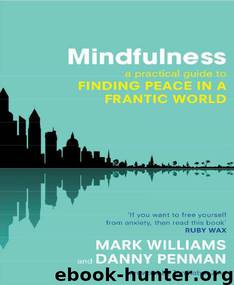Mindfulness: A practical guide to peace in a frantic world by Williams Prof Mark & Dr Danny Penman

Author:Williams, Prof Mark & Dr Danny Penman [Williams, Prof Mark]
Language: eng
Format: mobi
Published: 0101-01-01T00:00:00+00:00
easily we get sucked into their
drama.
Sounds and
Thoughts
Meditation3
Settling with breath and
body
Find a sitting position, in
Find a sitting position, in
which the spine can be self-
supporting, with your back
straight but not stiff.
1. Sit as described and with
your shoulders relaxed,
head and neck balanced
and chin tucked slightly
in.
2. Bring your attention to the
movements of the breath
in the body for a few
minutes, until you feel
reasonably settled. Then
expand your attention to
take in the body as a
whole, as if the whole
body
were
breathing,
helping you to be aware
of all the sensations in the
interior landscape of the
body.
3. Spend a few minutes
practising mindfulness of
the breath and body in this
way, remembering that in
the practice that follows
you can always come
back to the breath and
body to anchor yourself if
your mind becomes too
distracted
or
overwhelmed.
Sounds
4. Now, when you are ready,
allow the focus of your
attention to shift from
sensations in the body to
hearing – open to sounds
as they arise.
5. There is no need to go
searching for sounds or
listening out for particular
sounds. Instead, as best
you can, simply remain
open, so that you are
receptive to awareness of
sounds from all directions
as they arise – sounds
near, sounds far, sounds in
front, behind, to the side,
above or below. In this
way, you are opening to
the whole space of sound
around
you:
the
‘ s o und s c a p e ’ . Perhaps
notice how the obvious
sounds can easily crowd
out the more subtle ones;
noticing
any
spaces
between
sounds
–
moments of relative quiet.
6. As best you can, be aware
of sounds simply as
sounds, as raw sensations.
Notice the tendency we
all have to label sounds
as soon as they are
received
(car,
train,
voice, air conditioning,
radio), and see if it is
possible simply to notice
this labelling and then
refocus,
beyond
and
below the label, on the
r a w sensations of the
sounds
themselves
(including
the
sounds
within sounds).
7. You may find that you are
thinking about the sounds.
See if it is possible to
reconnect
with
direct
awareness
of
their
sensory qualities (patterns
of pitch, timbre, loudness
and duration), rather than
their
meanings,
implications or stories
about them.
8. Whenever you notice that
your awareness is no
longer focused on sounds,
gently
acknowledge
where
the
mind
has
moved to and then retune
the attention back to
sounds as they arise and
pass away from moment
to moment.
9. Then, after you have been
focusing on sounds for
four or five minutes, let go
of your awareness of
sounds.
Thoughts
10. Now shift your focus of
attention so that your
thoughts are centre-stage
in awareness – seeing
them, as best you can, as
events in the mind.
11. Just as with sounds,
where you were noticing
their arising, lingering and
passing away, so now, as
best you can, attend to
thoughts that arise in the
mind, noticing when they
arise, seeing as they linger
in the space of the mind
(like
clouds moving
across the sky of the
mind). Eventually, see if
you can detect the moment
when they dissolve.
12. There is no need to try to
make thoughts come or go.
In the same way that you
related to the arising and
passing away of sounds,
just let thoughts come and
go on their own.
13. Just as clouds moving
across a vast spacious sky
are sometimes dark and
stormy, sometimes light
and fluffy, so thoughts take
different
forms.
Sometimes clouds fill the
entire sky. Sometimes they
clear
out
completely,
leaving the sky cloudless.
14. Alternatively, you could
pay attention to thoughts in
the mind in the same way
that you would if the
thoughts were projected
on the screen at the
cinema
–
you
sit,
watching, waiting for a
thought or image to arise.
When it does, you attend
to it, so long as it is there
‘on the screen’, and then
you let it go as it passes
away. Notice when you
get drawn into the drama,
finding yourself up there
on the screen.
Download
This site does not store any files on its server. We only index and link to content provided by other sites. Please contact the content providers to delete copyright contents if any and email us, we'll remove relevant links or contents immediately.
Whiskies Galore by Ian Buxton(41880)
Introduction to Aircraft Design (Cambridge Aerospace Series) by John P. Fielding(33064)
Rewire Your Anxious Brain by Catherine M. Pittman(18553)
Craft Beer for the Homebrewer by Michael Agnew(18140)
Cat's cradle by Kurt Vonnegut(15186)
Sapiens: A Brief History of Humankind by Yuval Noah Harari(14252)
Leonardo da Vinci by Walter Isaacson(13183)
The Tidewater Tales by John Barth(12608)
Thinking, Fast and Slow by Kahneman Daniel(12077)
Underground: A Human History of the Worlds Beneath Our Feet by Will Hunt(12024)
The Radium Girls by Kate Moore(11921)
The Art of Thinking Clearly by Rolf Dobelli(10223)
A Journey Through Charms and Defence Against the Dark Arts (Harry Potter: A Journey Throughâ¦) by Pottermore Publishing(9232)
Mindhunter: Inside the FBI's Elite Serial Crime Unit by John E. Douglas & Mark Olshaker(9201)
Tools of Titans by Timothy Ferriss(8218)
Wonder by R. J. Palacio(8010)
Turbulence by E. J. Noyes(7936)
Change Your Questions, Change Your Life by Marilee Adams(7635)
Nudge - Improving Decisions about Health, Wealth, and Happiness by Thaler Sunstein(7615)
